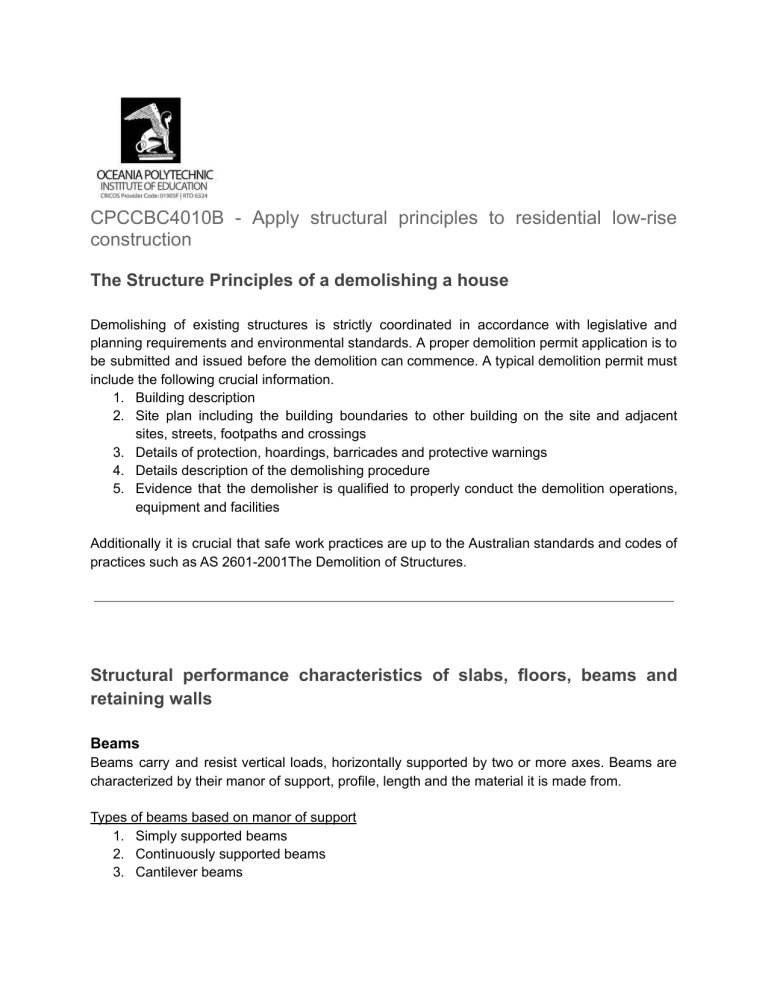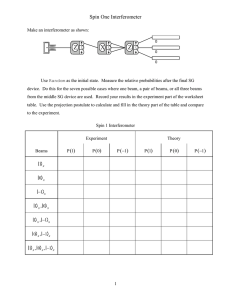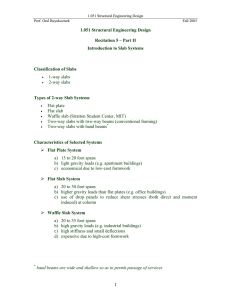
CPCCBC4010B - Apply structural principles to residential low-rise construction The Structure Principles of a demolishing a house Demolishing of existing structures is strictly coordinated in accordance with legislative and planning requirements and environmental standards. A proper demolition permit application is to be submitted and issued before the demolition can commence. A typical demolition permit must include the following crucial information. 1. Building description 2. Site plan including the building boundaries to other building on the site and adjacent sites, streets, footpaths and crossings 3. Details of protection, hoardings, barricades and protective warnings 4. Details description of the demolishing procedure 5. Evidence that the demolisher is qualified to properly conduct the demolition operations, equipment and facilities Additionally it is crucial that safe work practices are up to the Australian standards and codes of practices such as AS 2601-2001The Demolition of Structures. Structural performance characteristics of slabs, floors, beams and retaining walls Beams Beams carry and resist vertical loads, horizontally supported by two or more axes. Beams are characterized by their manor of support, profile, length and the material it is made from. Types of beams based on manor of support 1. Simply supported beams 2. Continuously supported beams 3. Cantilever beams Profile of beams 1. Solid rectangular beam ( wasteful as most of the stress occurs not at the center but rather at the top and bottom ) 2. I-shaped beam ( more efficient and cost effective ) 3. The shape and the thickness of the beams influence how much it can withstand the load before bending occurs. Length and material These two characteristics influence the bending in beams. The longer the span the greater the deflection.The relative strength of the material will also determine the bending in beams. Slabs Slab is a common structural element which consists of a flat, horizontal surface made of cast concrete. Reinforcement In most cases slabs require steel reinforcement to improve their ability to resist tensile stresses. Types of reinforcements There are several types of tools that can be used for supporting the reinforcement of the slab, such as bar-chairs, trench mesh, square mesh, reinforcing bars. Curing The concrete must be kept moist immediately after finishing to enable the chemical bonding between the cement aggregate and sand. Curing improve concrete strength and minimize surface cracks Floors The floor must be able to carry the entire load on top which includes the entire house and occupants. The type of soil on the premises must be carefully researched before the type of footing system is used. Failure to do so will result in structural cracking, sinking and other major issues. Layers of Floor The floor must be able to protect not only from natural environmental factors but also from noises and bugs and other micro intruders. 1. Sub-floor systems Concrete slabs. There are a number of different designs of slabs, depending on the site and soil requirements. 1. Slab on the ground 2. Suspended slabs 2. Structural flooring layer Sitting atop the sub-floor is the structural floor layer, often called the floor substrate. This sits under the final finished flooring material. 3. Final floor surface The final flooring surface that you walk on can be made of many things, such as timber, bamboo, particle board, etc. Walls Walls provide structural support to roof systems, allow for installation of services and provide the medium to add external and internal linings. Most common wall frame system in Australia is the timber stud wall frame, which consists of – 1. Top plate 2. Lintel 3. Common stud 4. Jamb stud 5. Jack stud 6. Nogging 7. Bottom plate 8. Timber or metal bracing 9. Sheet bracing Procedure for Metharom work teams to follow when demolishing a house Student guide 1. Prepare and apply for the demolition permit as discussed above in section 1. 2. Demolition preparation Structure - Identify materials, eg primary, structural and secondary lining materials. - Locate hazardous materials and notify authorities as required by OHS legislation. - Identify any special structural systems Services - Locate and identify services and supply mains, eg water, electricity, gas and extent of wires and pipes. - Locate and establish the extent of other services such as sewerage and drainage. Site - Locate depths of adjoining property footings where the building being demolished is close to the boundary or is likely to have an effect on the adjoining property. - Notify the building surveyor if any form of protection of the adjoining property is required. - Examine and record the condition of adjoining buildings particularly where they are close to the property boundary. - Locate and identify any common support structure for the adjoining property. Determine the location of any underground tanks. Determine suitable site entry points for personnel, plant and equipment and access to and from the site for vehicles. Determine crossing and infrastructure protection by hoarding or crossover boarding 3. Safe Work practices - Ensure all the demolition operations are up to the Australian standards and codes of practices such as AS 2601-2001The Demolition of Structures.



